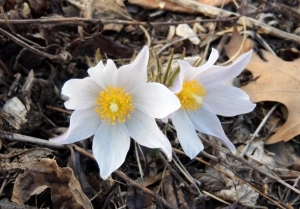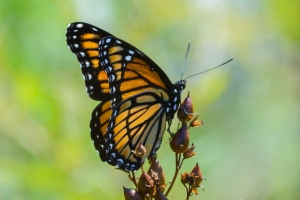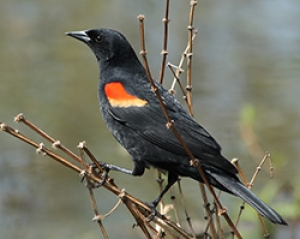
Short-lived Spring Wildflowers
Early spring brings us more than just sorely missed warmer temperatures with more daylight. It’s a “goldilocks zone” where the snow has melted but the trees' leaves don’t yet shade the ground. For a short period of time, when conditions are just right, spring ephemerals begin to bloom. Ephemeral - describing something as transitory or lasting for a short period of time - in this case, refers to the curious spring wildflowers we only see briefly each year around this time.
Spring Phenology Challenge
Spring is right around the corner, and it’s one of the most fun times of the year for phenology. As the snow melts and plants start sprouting, you can almost feel spring approaching in the air. Some animals, such as the Eastern chipmunk and the Blue Spotted Salamander, are waking up from their winter slumbers while others are returning from their annual southern migrations. Each year, we at the Urban Ecology Center have a staff competition to see who can observe the first Red-winged Blackbird at one of our parks. The males migrate back to the area in late winter, followed by the females a few weeks later. You could even beat our staff this year! Listen for their characteristic “VOTE-FOR-MEEEEE!” call. We also have challenges for documenting the first Mourning Cloak butterfly, Eastern Chipmunk, and Butler Garter snakes.
Milwaukee Winter Phenology Challenge and Fall Results
Back in September, the Urban Ecology Center challenged you to help document signs of fall using the free mobile phone app, iNaturalist, to record and submit wildlife and plant sightings to an international dataset. There were almost 400 observations that were submitted spanning 45 different species from September through November! New England Aster was by far the most documented species with 90 observations. Canada Goldenrod and Calico Aster were next two most documented species with the Asian Lady Beetle coming into fourth with 25 observations. Nice job to everyone documenting some sure signs of fall and participating in the Fall Phenology Challenge! Be sure to check out the results of the Fall Phenology Challenge here
Why are the trees brighter than I remember?
Have you noticed that the leaves have changed into brighter colors then you remember them being in the past? If you haven’t, go take a walk outside and see what you think about the leaf color. The reason that some years the colors of leaves seem brighter than others is because of the temperature and cloud cover. For the leaves to get bright, they need several warm sunny days followed by nights where it does not freeze. If this happens continually then it will be a good year for reds and bright leaves.
Milwaukee Fall Phenology Challenge and Summer Results
Back in June, the Urban Ecology Center challenged you to help document signs of summer using the free mobile phone app, iNaturalist, to record and submit wildlife and plant sightings to an international dataset. And wow – there were over 600 summertime observations that were submitted! With your help, 59 species were identified, which nearly met our total summertime challenge species goal! Some species of plants that evaded documentation were the Prairie Spiderwort and the Yellow Coneflower. On the wildlife list, both the Common Yellowthroat and the Dekay’s Brownsnake were left undocumented.
Milwaukee Summer Phenology Challenge and Spring Results
Back in March, the Urban Ecology Center challenged you all to help document signs of spring in Milwaukee using iNaturalist (free mobile phone app) as a means of documenting and submitting data to an international dataset. There were nearly 400 springtime observations that you all recorded! You all helped identify 32 species which is nearly all of the species we challenged you with spotting. I couple of species that eluded documenting, was the Pasque Flower and the Spring Peeper. Both can be tough to spot! Additionally, we had 84 people submit data that fit within our phenology challenge requirements. Bloodroot had the most number of identifications with 44 people spotting it.
How you can Connect to Nature and Contribute to Research!
We know COVID-19 is affecting everyone in Milwaukee County in many different and difficult ways. We are now spending a lot of time indoors living, working, and teaching as we care for ourselves and one another through physical distancing. However we also know that nature has incredible healing and calming powers that we want you to take advantage of during this stressful time. Whether that is in your backyard, in a park, or even through your window, we hope you have the chance to interact with the outdoors. Before you head outside, please abide by all health and social distancing recommendations by the CDC as well as by local health officials as they can change with every passing day. Please use your best judgment as your safety and ultimately the public’s safety is of utmost importance.
Mourning Cloaks and Butlers, the Silent Heralds of Spring
Met with the blaring calls of the Red-winged Blackbirds and joyful chatter of Robins when stepping outside, you know it’s springtime in Wisconsin. These sounds create a feeling of warmth and excitement for the summer months that are just around the corner, and are a sure sign of the changing seasons. There are, though, harbingers of spring that aren’t so vociferous. In fact, two species in particular are rather silent in their seasonal debut, but just as telling. The Mourning Cloak butterfly and the Butler’s Gartersnake are two species that rise from their winter hibernation rather than migrating back into Wisconsin.
Take a Virtual Nature Walk with Chad!
We're encouraging our staff to share the natural discoveries they've found on their walks. Come along on a "virtual nature walk" with our Environmental Educator Chad Thomack, and hear stories about his recent discoveries in nature!
Phenology in the Time of a Pandemic
There are few rules to hiking beyond “leave no trace” and “stay on the trail,” but another unspoken one is “give other folks their space.” In other words, polite hikers have been practicing “social distancing” for ages! Just because kids don’t have school to go to for the time being doesn’t mean we all have to spend the next bit of time cooped up in the house. In fact, the natural world has kept on doing its thing while we’ve been busy with math assignments and playdates and seemingly endless meetings, and spring is the perfect time to get back out there. The Urban Ecology Center’s mission to connect people in cities to nature isn’t going anywhere, and this is the first in a series of blog posts with ideas on how to keep getting outside.
Copyright © 2023 The Urban Ecology Center












